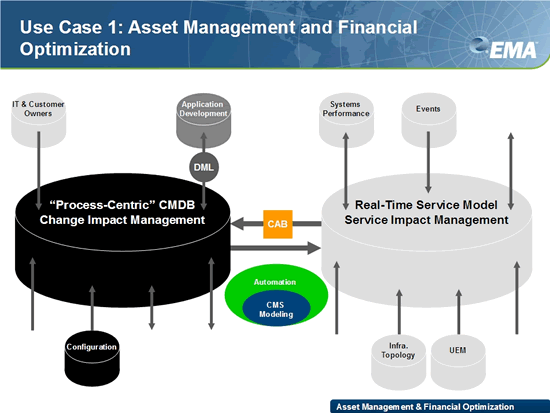Asset Management is often the fastest use case to deploy for an initial phase CMDB/CMS because, as one vendor put it, “It’s the most linear use case” and generally speaking the least time sensitive. As a result it’s probably the most popular initial use case for CMDB/CMS initiatives -- which doesn’t mean it’s necessarily the right first phase deployment for you. You should start where your needs, and your readiness, combine to give you greatest value –- which could be any one of the three here.
Some specific use cases for asset management include:
Asset and Inventory Analysis: This most often comes up in broadly based asset management initiatives, but it is also relevant to the other use cases – and ALWAYS a challenge.
Asset Lifecycle Management: This includes SLAs, maintenance windows, and service contracts, and is central to managing assets effectively across their lifecycles. Strong support for SW license management is also important. This is often achieved through separate but well integrated solutions –- including third-party solutions.
Compliance Audits: These can now be far more effectively automated and structured based on consistent policies once assets are mapped into a CMDB/CMS system.
Financial Optimization: This is essentially optimizing your IT mission from a dollars-and-cents perspective. CMDB/CMS-driven asset and service management initiatives lay the core foundation for capturing and analyzing cost and value metrics in a substantive and contextually consistent way.

Figure 2: The darker the color, the more central the capability is to the use case. As you can see, the core CMDB, asset management and configuration management are all in black. Next in line are application dependency mapping, capacity, usage and optimization, and application development (as new application services can also be viewed as assets and relevant to asset planning and financial optimization).
EMA had four categories for assessing vendors in its radar: Value Leader, Strong Value, Specific Value, and Limited Value –- from highest to lowest. The value leaders from the radar in Asset Management and Financial Optimization were:
ASG
ASG is arguably the most platform-like of all the vendors in the radar in terms of breadth of capability and function, ASG was one of four Value Leaders in Asset Management where it received the highest overall score of any vendor. Relevant to this, ASG-Trackbird for asset management also received a Value Leader ranking in EMA’s May, 2011 radar on Software Asset Management. ASG offers a CMDB design that’s matured to focus on real needs and use cases -- with an exceptional ability to take in third-party information from a wide variety of sources.
iET Solutions
iET Solutions received especially high ratings in Cost Advantage but clear dominance in all function-related and cost-related vectors. The company’s strengths come in part from well thought out process flows to support asset lifecycle management along with its solid integration capabilities for third-party sources. It was really a balanced solution -- and offered the only deployment where the CMDB was working across a fully third-party management landscape.
LANDesk
LANDesk Service Desk Suite excelled across all areas for Asset Management and scored a first place total score (closely followed by ASG) across all eleven vendors for Asset Management and Financial Optimization. LANDesk’s Service Desk Suite is enhanced by integrations with its own Asset Lifecycle Manager which was one of the Value Leaders in EMA’s Software Asset Management Radar from May, 2011.
ServiceNow
ServiceNow's CMDB outperformed the vendor average in all areas -- with especially strong support for Integration and Interoperability and top-ranked scores for automation in Functionality. ServiceNow’s capabilities to assimilate relevant third-party sources, map them via strong discovery and inventory, and set up process automation for lifecycle control are all impressive. As you may know, ServiceNow also shook the industry by successfully establishing the SaaS model in this space –- and it continues to grow at a dramatic pace.
Click here to read the CMDB/CMS use cases for Change Management and Change Impact Analysis
Click here to read the CMDB/CMS use cases for Service Impact Management
